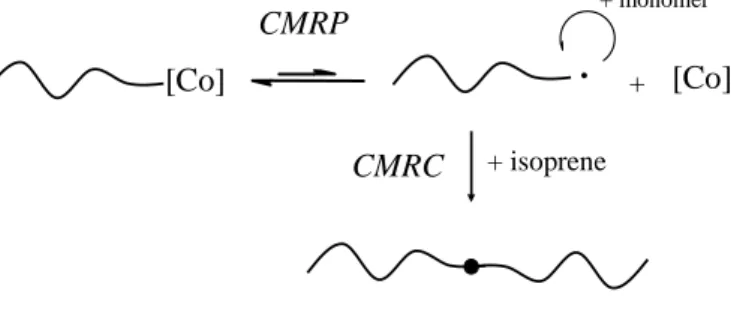Cobalt-Mediated Radical Coupling (CMRC), a powerful route to the
preparation of novel ABA triblock copolymers
Christophe Detrembleur,* Antoine Debuigne, Christine Jérôme
Allée de la chimie, 3, Bld B6a, Sart-Tilman, Liege.
Center for Education and Research on Macromolecules, University of Liege. Liege, Belgium
christophe.detrembleur@ulg.ac.be
Nowadays, progresses in medicine, biotechnology, microelectronic and many other fields are more and more sustained by the development of novel polymer materials with constantly improved properties and well-defined molecular parameters. Controlled radical polymerization (CRP) techniques are powerful tools for that purpose by giving access to a large range of polymeric materials with low molar mass distributions, predictable molar masses and precise architectures.
This communication aims at presenting synthetic and mechanistic features of two macromolecular engineering tools based on a cobalt complex, Co(acac)2. The first one is a
controlled radical polymerization technique called Cobalt Mediated Radical Polymerization (CMRP)1-5. And the second one is an efficient radical polymer chain coupling reaction called
Cobalt Mediated Radical Coupling (CMRC)6.
In the case of CMRP mediated by Co(acac)2, the controlling agent is a cobalt complex
(Co(acac)2) which reversibly forms a Co-C bond at the chain-end of the polymer.1 At any
time, a large number of polymer chains capped by a cobalt complex are in equilibrium with a tiny amount of propagating species such that the extent of irreversible termination reactions that occur between radicals by coupling or dismutation is avoided. The reversibility of the deactivation is ensured by homolytic cleavage of the Co-C bond by thermal treatment (Figure 1) or radical exchange.
Temperature, solvents and use of ligands have strong influence on the course of CMRP mediated by Co(acac)2. These features will be addressed in the presentation.
Interestingly, this CMRP process is efficient for controlling both conjugated (acrylates, acrylonitrile (AN)) and non-conjugated monomers (vinyl acetate (VAc), N-vinyl pyrrolidone (NVP)). More importantly, by the fine-tuning of the Co-C bond at the polymer chain-end by metal coordination, block copolymerization between these two monomers families is now possible, giving access to new copolymers that are not available by any other existing CRP techniques.1 Main synthetic possibilities of CMRP will be presented.
.
+ [Co][Co]
+ monomer CMRP
CMRC + isoprene
Figure 1 : General scheme for the Cobalt-Mediated Radical Polymerization (CMRP) and Coupling reaction (CMRC).
Occurrence of termination during CRP is detrimental to the control of the molecular parameters and leads to materials with large and/or multimodal molar mass distributions. A notable exception to this rule is the case where termination is fast, quantitative and proceeds specifically by coupling. In that case, a perfect doubling of the polymer molar mass is expected without broadening of the molar mass distribution. Such a quantitative coupling process should be a powerful synthetic tool since α-functional polymers and diblock copolymers should lead to the corresponding telechelic and triblock copolymers, respectively. Such a radical coupling process, named ATRC (for Atom Transfer Radical Coupling) 7,8, is reported in literature. However, high coupling efficiencies are restricted to polymer precursors with relatively low molar masses.
Recently, we reported a new radical coupling method6 which consists in addition of isoprene to polymer precursors formed by CMRP using Co(acac)2 as controlling agent.
Treatment of well-defined PAN precursors, capped by bis(acetylacetonato)cobalt complexes, exclusively lead to the coupling product (PAN-b-PAN)6. In this case, the extent of coupling was above 95% even for PAN precursors with molar mass as high as 25000 g/mol (Figure 2) and the coupling reaction is very fast. This cobalt-Mediated Radical Coupling (CMRC) method also proved efficiency for preparing symmetrical triblock copolymers when applied to a diblock precursor. For example, well-defined PVAc-b-PAN-b-PVAc copolymers have been prepared starting from PVAc-b-PAN-Co(acac)2 diblock precursors, and have been hydrolyzed
into the poly(vinyl alcohol)-b-poly(acrylic acid)-b-poly(vinyl alcohol) (PVOH-b-PAA-b-PVOH) hydrosoluble copolymer.6 Recent mechanistic advances in Cobalt-Mediated Radical Polymerization Coupling (CMRC) reaction as well as expected impact of this technique in macromolecular engineering will be discussed in this talk.
References
1
Debuigne, A.; Poli, R.; Jerome, C.; Jerome, R.; Detrembleur, C. Prog. Polym. Sci 2009, 34, 211-239 ; and references therein.
2
Wayland, B. B.; Poszmik, G.; Mukerjee, S. L.; Fryd, M. J. Am. Chem. Soc. 1994, 116, 7943-7944.
3
Debuigne, A.; Caille, J.-R.; Jerome, R. Angew. Chem. 2005, 44, 1101-1104.
4
Debuigne, A.; Michaux, C.; Jerome, C.; Jerome, R.; Poli, R.; Detrembleur, C. Chem. Eur. J.
2008, 14, 7623- 7637.
5
Debuigne, A.; Champouret, Y.; Jerome, R.; Poli, R.; Detrembleur, C. Chem. Eur. J. 2008,
14, 4046-4059. 6
Debuigne, A.; Jerome, C.; Detrembleur, C. Angew. Chem., Int. Ed. 2009, 48, 1422-1424.
7
Yurteri, S.; Cianga, I.; Yagci, Y. Macromol. Chem. Phys. 2003, 204, 1771-1783.
8
Sarbu, T.; Lin, K.-Y.; Ell, J.; Siegwart, D. J.; Spanswick, J.; Matyjaszewski, K.
Macromolecules 2004, 37, 3120-3127.
Acknowledgements.
The “Belgian Science Policy" in the frame of the "Interuniversity Attraction Poles Programme” (PAI VI/27), and the “Fonds National de la Recherche Scientifique” (F.N.R.S.) are acknowledged for financial support. A. D. and C. D. are “Chargé de Recherches” and “Maître de Recherches” by the F.N.R.S, respectively. The authors thank G. Cartigny for assistance.
